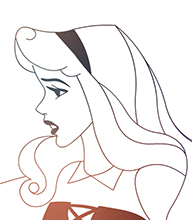Why Angelina Jolie tapped Lana Del Rey to sing “Once Upon a Dream” for Maleficent, Disney’s first rape-revenge film.
I know you, I walked with you once upon a dream
I know you, that look in your eyes is so familiar a gleam
And I know it’s true that visions are seldom all they seem
But if I know you, I know what you’ll do
You’ll love me at once, the way you did once upon a dream
Maleficent is for grown ups. That’s what I thought, watching the trailer for it with my kid last winter before a matinee screening of Frozen. It was an unexpected thrill: Angelina Jolie, more gorgeous and goth than ever, with prosthetic cheek bones and leather horns, is a vengeful fairy who confronts a cowering king in the first ten seconds. (“Well, well . . .”) Then, Lana Del Rey’s vocal begins.
“I know you, I walked with you once upon a dream,” she sings, a cappella for a few lines, in a slowed-way-down version of Princess Aurora and Prince Philip’s theme song from the 1959 animated classic Sleeping Beauty. Del Rey’s timbre instantly evokes the atmosphere of her oeuvre. More than a hazy, Instagram-y dream world, it’s a signature dissociative state—being sad but feeling beautiful, observing one’s own desolation through the lens of a tingling body high. Fairy tales are set in a mythic realm of feudalism and candelabras, but, of course, they’re written and rewritten to reflect contemporary anxieties and aspirations. Who better than Del Rey—with her thing for tragic archetypes, her widespread castigation as a fraud, and her rise to stardom despite it—to bring Maleficent’s excavation of female evil, its themes of cruelty, enchantment and transformation, into the present?
During the trailer’s montage of lush CGI action, Maleficent fills a cradle with curls of acid-green vapor, and a spinning wheel’s needle gleams ominously. As eerie and majestic orchestral instrumentation joins Del Rey’s voice, giant tree-creatures explode from the ground for a supernatural battle between the magical land of the Moors and the human world it borders. For most of this, my kid—she was still four, then—clutched my forearm and stared at my rapt expression instead of the screen. So, I didn’t bring her when I went, opening weekend, to see Maleficent, Disney’s first rape-revenge film.
Written by Linda Woolverton (Beauty and the Beast, The Lion King), it was conceived as a prequel to, and revision of, Sleeping Beauty, in which the glamorous villain’s curse upon Princess Aurora at her christening would be put in context. The old Maleficent’s evil was capricious and congenital; the new one would have a real motive. “The biggest challenge was how to make a villain into a protagonist,” Woolverton told The Hollywood Reporter, “How on earth was I going to justify that this woman would curse a baby?” Inspiration struck as she studied the original animated character. Maleficent is supposed to be a fairy, but where are her wings? Woolverton decided that they had been taken.
The act itself, the severing of her powerful wings from her drugged body, isn’t shown. Instead, we see Stefan—a human, Maleficent’s childhood love who’s grown into a weak and power-hungry man—come up with the idea. He can’t bear to kill her, but he’s got to show proof of her defeat to become the king’s successor. Cut to her waking: Maleficent screams with anguish as she rises, and when she walks, she stoops, wincing with pain. “We were very conscious, the writer and I, that it was a metaphor for rape,” Jolie said of the scene a couple of weeks ago, during a BBC Women’s Hour interview regarding her appearance at the Global Summit to End Sexual Violence in Conflict. Though the scene is coded as date rape, with its long walk in the woods and trust-building conversation before the sleeping potion is introduced, it also resembles “sexual violence in conflict,” where the rape, maiming, and humiliation of civilians terrorizes a population and produces grotesque trophies, like the wings Stefan keeps in a glass case when he’s king.
In the wake of the assault, the Moors darken and Maleficent morphs from benevolent protector to despotic mistress, signaled by a change in her costumes’ color schemes—from mossy browns to dominatrix black. Speaking to Vanity Fair about the fabrication of her character’s horns, Jolie explained, “Actually we went online and found these great leather workers and people who do these more, kind of, elegant fetish clothes.” But, of course, the kinks get straightened out. I don’t want to give too much away, so suffice to say, Maleficent—however slyly campy, misandrist, moving, and much better than traditional Disney fare it is—conforms to a mandatory narrative arc of redemption through love. And it is, after all, a movie for kids. The trailer’s dread-inspiring version of “Once Upon a Dream” is saved for the film’s credits, after we know that everything turns out OK.
Maleficent became Jolie’s highest grossing movie the same week that Del Rey’s Ultraviolence took the number 1 spot on the Billboard 200. It’s the sophomore triumph to disprove the smoke-and-mirrors theory that Del Rey’s “Video Games” buzz was pure hype and Born to Die marked the official exhaustion of a one-trick persona. In her new songs, the sardonic, aggressive edge to her impressionistic lyrics is sharper, and there’s something like anger in her relentless sexy posturing. The press emphasized that Jolie herself—megastar, businesswoman, Special Envoy for the UN High Commissioner for Refugees, mother of six, and once-upon-a-time cutter—tapped Del Rey to perform the fairy tale cover, and I’d like to think it’s because she gets it, why her cinematic aura of loss and longing belongs with the origin story of Maleficent’s “evil.” In the trailer, Del Rey’s voice—what it sounds like, what cultural anxieties it provokes—sets up the horror of Maleficent’s traumatic past. And when the credits roll, it’s a haunting postscript to the Disney resolution. Del Rey represents the real possibility of an unhappy ending.
